
The above picture is from one of the first sequences of 2001: A Space Odyssey, involving tribes of apes that discover how to use bones as weapons and fight with their rivals by those bones. Stanley Kubrick, the director, won Academy Awards for the "best special visual effects" for this film. 2001: A Space Odyssey has usually been regarded as one of the most influential films ever, and proved remarkably inspirational for the development of VFX.
Annotated Bibliography
Through the Looking Glass: Philosophical Toys and Digital Visual Effects
-
Prince, S. (2010) 'Through the Looking Glass: Philosophical Toys and Digital Visual Effects', Projections, 4(2), pp. 19-40

In this article, Prince, as a prominent professor of cinema, regards cinema as a dialectic of art and science. This dialectic played a significant role in the invention of digital imaging and cinema. Prince suggests that perceptual realism is the “major goal” of digital effects artists whereby they can persuade viewers to believe in the narrative and the world created by the film. He doubts the criticism that DVFx often receives, such as the view that these effects are anti-narrative and would damage the aesthetics of realism. Those criticisms rest upon some questionable assumptions such as the claim that VFX is limited to spectacle, or a systematic scepticism about human vision and imaging. The article also discusses how artists and natural philosophers cooperate in the development of techniques and instruments whereby cinema has flourished. Prince questions the common belief that overlooks the role of science in the emergence of cinema, alongside entertainment purposes. Prince elaborates the development of image-making devices such as phenakistoscope, and he shows us how scientific study of vision, depth perception and visual persistence research paved the way for the invention of cinema and a new aesthetics experience of reality. He insists on viewing cinema as a combination of popular culture and scientific demand, resulting in the invention of “philosophical toys” and novel image-making techniques which serve science and art both. Prince uses Zodiac and The Curious Case of Benjamin Button as instances of the way DVFx provides filmmakers with new methods whereby they succeed in establishing indexical and perceptual realism by way of imaginative use of computer technology and methods such as photogrammetry, CG imagery, and complex motion tracking. These conclusions add weight to the argument that not only is visual effects not an obstacle in the way of narrative, but it is also of great benefit to cinema in terms of indexical and perceptual factors.
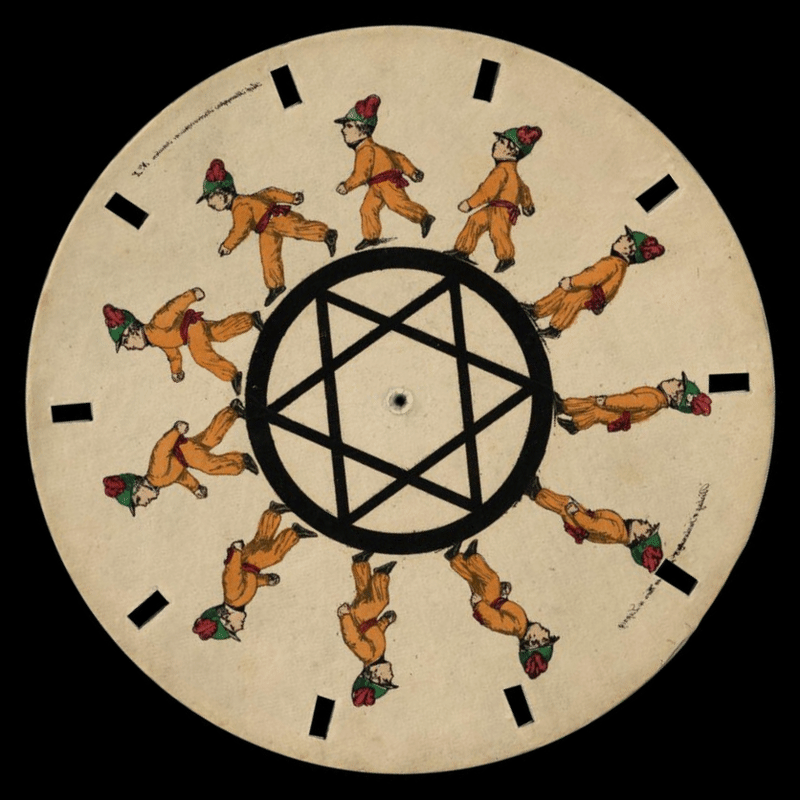
Prof. Stampfer's phenakistiscope (1832)
Digital storytelling: the narrative power of visual effects in film - Chapter 10
-
Mcclean, S.T. (2008) Digital storytelling : the narrative power of visual effects in film. London: The MIT Press.

In chapter 10th, Shilo McClean relates DVFx to the early cinema which is regarded as "cinema of attractions" by Tom Gunning. McClean shows us how digital effects connect to one of the cinema's earliest ambitions: exploring new wonders and adventures. She suggests that DVFx can support the worldview that we are living in a mutable space approaching the proposed visions of an explorable and manipulable future with the aid of VFX and CG methods. She observes that CG images are already a powerful tool in architectural practice and cities construction. Cinema, as she argues, is the interaction of the imaginary and the real, which not only can reveal the future, but also strongly influences it. McClean argues that the tension between narrative and spectacularity mostly rests upon the weakness of dramatic elements, which can bludgeon filmmakers into overusing of the effects. However, DVFx are usually seamless, or in many cases, they help the narrative to be believed by way of engaging the spectators. McClean cites the example of 9/11 when CG destructions and the physical world match closely, as many saw that day as a sequence of a disaster film. In this chapter, she encourages us to understand how DVFx serve the needs of filmmakers to be better storytellers, particularly in science-fiction films where other worlds and faraway places are displayed.

Many described 9/11 events as something very similar to a sequence of a film.
What is Digital Cinema? by Lev Manovich (2001)
-
Manovich, L. (1995) What is digital cinema?. Available at: http://manovich.net/content/04-projects/009-what-is-digital-cinema/07_article_1995.pdf (Accessed: 24 Oct 2020).

Lev Manovich, a professor of Computer Science at the City University of New York, in his article, tries to give us a definition of digital cinema, by drawing our attention to the cultural history of the moving images. He argues that narrative is only one aspect of cinema, and cinema should not only be understood as a means of storytelling. He also claims that cinema, since its birth, has been the art of motion, or even a subgenre of painting, consisting of innovative techniques for creating moving images and manipulating them. Manovich then addresses the changes in the filmmaking process and maintains that digital cinema betrays a return to 19th-century pre-cinematic moving images techniques such as hand-painting and hand-animating practices. Shifting to digital media, he insists, live-action footage becomes only a raw material among other elements like CG images and computer animation film-like scenes for making a film. He explains how the logic of filmmaking process has been redefined by digital cinema in a way that it has merged the production and post-production processes into one, removed the distinction between cinema and animation, and finally subordinated the meaning of cinematic realism and narrative.

The Code (2011) -'Shapes' episode
-
BBC2 England (2011) The code, Shapes. Available at: https://learningonscreen.ac.uk/ondemand/index.php/prog/01E00B35?bcast=68266791 (Accessed: 26 Oct 2020).

In Shapes episode, and particularly in the section on fractal patterns and CGI, the presenter, Marcus du Sautoy, talks about the mathematical structure of nature and its use in generating computer graphics. He helps us to get a good grasp of what fractal patterns are, especially to understand why they are essential for CGI. During a section of this episode of the programme, Sautoy draws our attention to one of the most contentious and eccentric artists of the 20th century, Jackson Pollack, whose paintings were amazingly influential, albeit so bizarre. Talking to Richard Taylor, an artist and physicist studying Pollack's work, Sautoy reveals how fractal patterns have made Pollack's work so appealing. He then refers to French mathematician Benoit Mandelbrot, whose works suggest that a similar simple mathematical code of fractals can explain nature. Sautoy also interviews Lauren Carpenter, the co-founder of Pixar company. In the 1980s, Carpenter was inspired by fractal geometry of Mandelbrot, thereby inventing an algorithm to produce the mountains pictures during a project for the aircraft manufacturer of Boing. Sautoy then depicts how the rules of repetition and self-similarity helped Carpenter to make a seminal animation at that time. He suggests fractal mathematics is the key for animators and computer scientists to create complex CG images.

Using the maths of fractals to make patterns of triangles in creating the mountains

The Mandelbrot set generated by iteration.
Uncanny valley: why we find human-like robots and dolls so creepy. by Stephanie Lay
-
Lay, S. (2015) 'Uncanny valley: why we find human-like robots and dolls so creepy', The Guardian. Available at: https://www.theguardian.com/commentisfree/2015/nov/13/robots-human-uncanny-valley (Accessed: 02 Nov 2020).

Stephanie Lay, as a researcher of the uncanny valley, in this article, discusses the underlying reasons why we feel uneasy and eerie when encountering near-human robots and entities. The uncanny valley was first theorised by Masahiro Mori who was a Japanese roboticist. Mori speculated that there is a dip in emotional response to a human-like robot. It happens when a robot is very similar to a human in a way that it would elicit discomfort in people, instead of positive response. Lay explains that Mori’s hypothesis of the uncanny valley has been still a topic of interest and debate, although it is a hard-to-research subjective issue. She tries to provide some explanations for the occurrence of the uncanny valley effect. She first suggests that the effect happens when the line between non-human and human is crossed. As another explanation, she argues that we get an eerie sense when we think that a near-human robot has a mind, like us. Finally, Lay claims that the uncanny valley can also happen owing to discrepancies between a robot’s appearance and its behaviour.

This picture is from a notorious scene of Scorpion King (2002) played by Dwayne Johnson. This scene is widely considered as one of the worst CG scenes ever by many critics and the audience.
The Uncanny Valley by Masahiro Mori (Translated by Karl F. MacDoman and Korri Kageki)
-
Mori, M. (2012) ‘The Uncanny Valley’, IEEE Robotics & Automation Magazine, pp. 98-100.

Masahiro Mori, a roboticist well-known for his theory of the uncanny valley, in this essay, focuses on people’s response to robots that are very similar to human beings. He claims that there is a dip in emotional response to a lifelike robot where the robot is very close to human in terms of appearance and behaviours. He called this dip the uncanny valley in which a person would find the near-human robot eerie. Mori demonstrates the uncanny valley effect by a graph showing the relation between human likeness and affinity sensation in people. According to his graph, for instance, we lose the sense of affinity when we encounter a prosthetic hand and notice that the hand is artificial. He suggests that the eeriness elicited from the people intensifies when a human-like robot moves. Therefore, on another graph, he shows how the presence of movement can deepen the uncanny valley effect. The essay concludes that a very high degree of human resemblance could not always be helpful, so building human-like robots should not always be an objective for robotics. To avoid the uncanny valley occurrence, he suggests that roboticists follow nonhuman design policies instead.


The Uncanny Valley graphs.
The Twelve Principles of Animation
In 1981, two Disney animators, Ollie Johnston and Frank Thomas, in their book 'The Illusion of Life: Disney Animation' introduced 12 elementary laws and principles of animation. Since then, these principles have become a wildly-recognised must-learn, essential for all animators, especially 2D hand-drawing ones. However, the principles are still of great importance to today's 3D computer animators as well. The principles below are paraphrased from the above-mentioned book:
-
Squash and Stretch
-
Anticipation
-
Staging
-
Straight ahead action and pose to pose
-
Follow through and overlapping action
-
Slow in and slow out
-
Arcs
-
Secondary action
-
Timing
-
Exaggeration
-
Solid drawing
-
Appeal

Squash and Stretch
'Squash and stretch' principle gives the drawing an illusion of character's elasticity, volume, flexibility and weight.
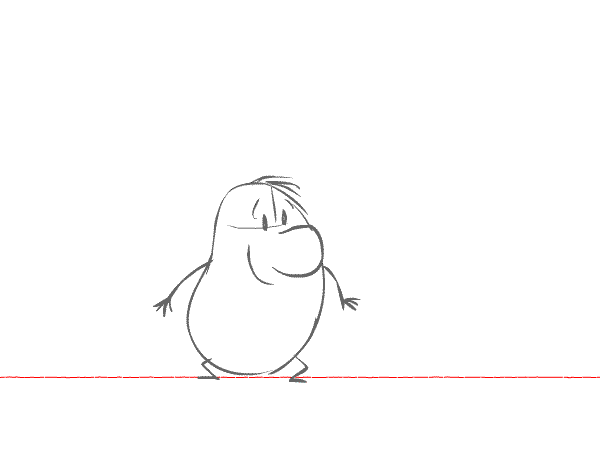
Anticipation
Anticipation is considered for preparing the action which is going to happen next.

Staging
The essence of this principle is directing the audience’s attention to the most essential elements of the scene and keeping the focus on the relevant and clear actions.
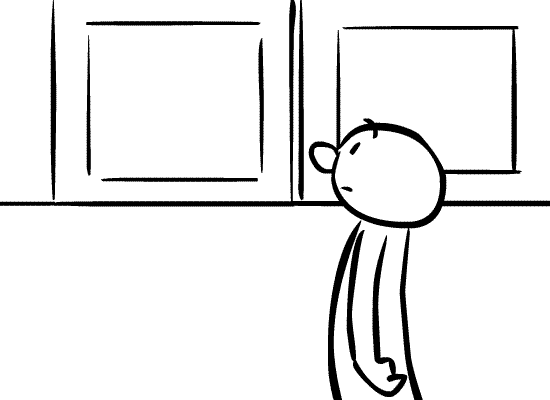
Straight ahead action and pose to pose
There are two different approaches to drawing an action: either drawing out a scene frame by frame from the beginning to the end or only drawing a few keyframes and filling in the intervals. The second one is the technique wildly used by computer animating software.

Follow through and overlapping action
This principle explains how to animate a character coming to a stop. When stopping, parts of the character like hair, clothing, etc. might continue to move in the same direction of moving. However, all parts of the body do not move evenly together.

Slow in and slow out
In reality, nothing moves with constant speed. To create believability, animators may change the speed of movement by drawing more frames at the start of the action, fewer frames in the middle, and more frames again at the end.
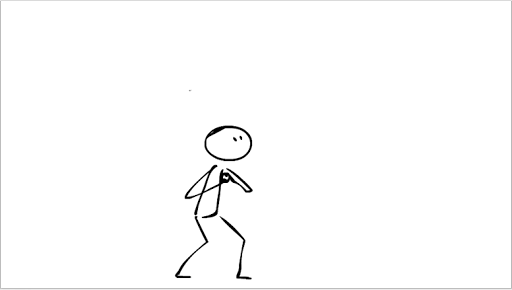
Arcs
Basically, characters and objects should not move in a straight line. Like real life, they move in circular paths called arcs.

Secondary action
Secondary action is an extra action that supports the main action and adds more dimension to the character's action.
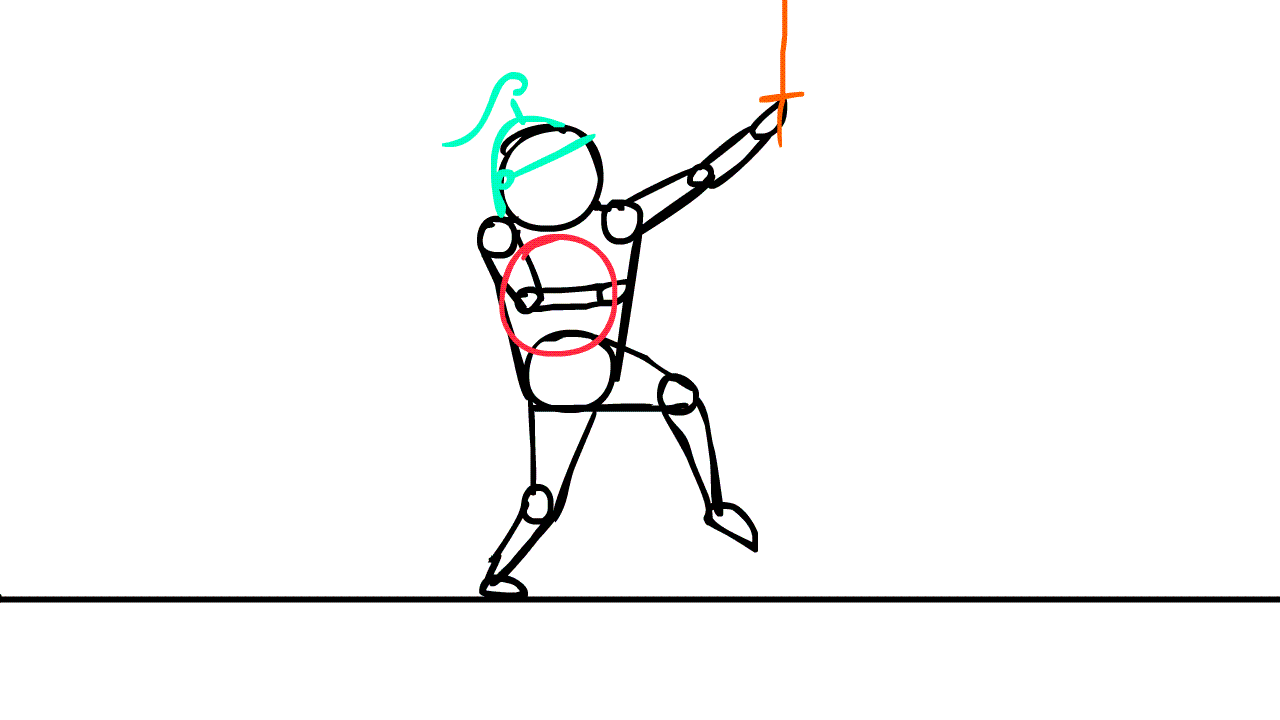
Timing
More frames/drawings to create slower action and less frames/drawings for showing faster action.

Exaggeration
Exaggerating of a character, their personal traits, behaviour, condition, and motions. Exaggeration is useful when reality can seem static and dull.
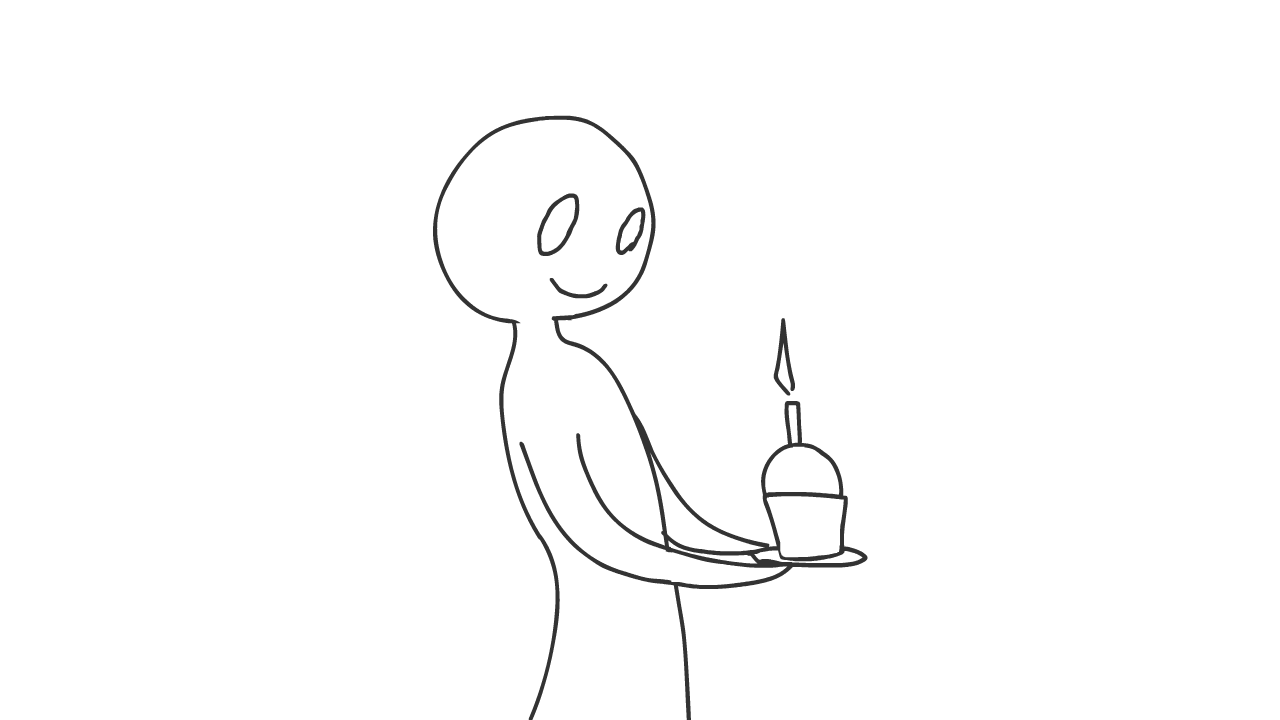
Solid drawing
This principle is particularly useful for 2D hand-drawn animations. It says animated characters should be drawn as though they are in three-dimensional space.
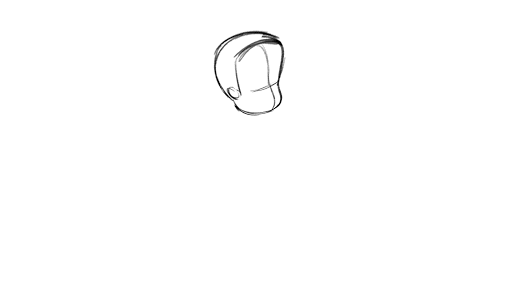
Appeal
And the last principle is about compelling attractiveness or charm so that the character and animation can engage the audience's interest and attention.


Avoiding the Uncanny Valley by Bobby Azarian
-
Azarian, B. (2015) 'Avoiding the Uncanny Valley', Slate. Available at: https://slate.com/technology/2015/10/research-supports-the-uncanny-valley-theory-of-human-robot-interaction.html (Accessed: 1 Dec 2020).

Bobby Azarian, in this article, Avoiding the Uncanny Valley, explains how researchers have tested the Uncanny Valley hypothesis since its birth in 1970. He argues that, as robots are continually getting closer to human appearance, evaluating the hypothesis is crucial for today’s robotics design policies. He explores some earlier and recent studies implying different and even inconsistent results, some supporting and others conflicting the Uncanny Valley effect. For instance, on the one hand, research carried out in 2005 suggests that the negative response to near-human robots are due to design flaws, not the level of human likeness. On the other hand, a more recent study by the Cognition journal hugely supports the hypothesis. It shows how resemblance to human beings, at a particular point, results in people feeling less affinity for lifelike robots. Azarian, then asserts that small flaws in the design of robots can easily invoke unsettling sensation by making us feel that robots are impersonating humans. Also, he explains that so far, researchers have used static images of robots instead of dynamic videos, to determine how people respond to them and evaluate the effect. He claims that this scientific approach has limited the accuracy of testing the hypothesis, so future investigations need to be carried out more inventively and reliably.

My essay topic:

The Uncanny Valley: does it exist?
-
Brenton, H. et al. (2005) 'The Uncanny Valley: does it exist?'. Available at:http://www.davidchatting.com/research/uncanny-valley-hci2005.pdf (Accessed: 07 Dec 2020).
.png)
This article discusses the Uncanny Valley effect and investigates the evidence for it. The authors do not wholeheartedly concede the valley model and its graph showing people’s emotional response to the similarity of a virtual agent. However, they admit that there is extensive anecdotal evidence from CGI, film and sculpture to support that, although the model itself is not scientifically tested yet. The article emphasises that our understanding of the effect is too limited, and supporting studies are not yet thorough and precise enough. However, based on anecdotal evidence, the effect is widely accepted and prominent among designers, roboticists, artists and character creators. Reviewing some different pieces of evidence for the Uncanny Valley, the paper suggests four working hypotheses aimed to encourage further studies: First, authors refer to Mel Slater’s theory of VR presence. They assert that this theory can be beneficial to researchers of the Uncanny Valley. Second, the paper claims that when there is a high level of realism, it would be critical for appearance and behaviour to match each other up. Third, the importance of the eyes can be a fundamental reason for the effect, as we are attuned to reading emotions from the eyes and faces. Last, the writers argue that the Uncanny effect is culturally dynamic and can change over time, like our reaction to the first projection of flat humans on screens in cinema history.




The Uncanny Valley in Games and Animation - a book by Angela Tinwell
-
Tinwell, A. (2014) The Uncanny Valley in Games and Animation. Massachusetts: A K Peters/CRC Press. 1st edition.

In the first chapter of her book, the Uncanny Valley in Games and Animation, Angela Tinwell elaborates what the uncanny is and why it is still a critical and prevalent theory in CG character design. She first tries to introduce the psychological reasons why the phenomenon exists, at least based on anecdotal evidence. Second, she investigates the factors as to why the human-like CG characters would fall into the Uncanny Valley. Ernst Jentsch was the earliest who wrote about the uncanny in his essay “On the Psychology of the Uncanny” (1906). Jentsch put forward that the effect is associated with an intellectual uncertainty about whether a lifelike automaton is real or unreal, alive or dead, or human or nonhuman. Jentsch believed that the effect had been widely used as an artistic device to produce tension and dread in the horror/fantasy genre of literature. As the second instance, the article refers to Sigmund Freud’s article named The Uncanny (1919). Freud, in his article, first referred to the exact meaning of the word “uncanny”, defined as “not known” and “unfamiliar”. He then claimed that the uncanny effect occurs when the repressed and the hidden come into sight and reveal. Freud asserted that one feels uncomfortable when something hidden in others reveals, but most importantly, when something repressed or hidden in oneself appears. Tinwell uses the Freud theory to argue that when one feels uneasy confronting false facial expression in a near-human character, it may cause uncertainty about who one is and how others may perceive them. She then explains Mori’s uncanny valley theory (1970) and how the increase in the human likeness would evoke an eerie and unsettling sensation in the audience. In another section, Tinwell points out the recent technological advances and methods in CG character design and discusses how a very similar uncanny phenomenon has been frequently recognised and discussed in the fields of Animation and Game Design. She explains how motion-capture systems played a significant role in the uncanny's experience in 3D near-human characters. The film “Final Fantasy” (2001) was the first that provoked debates and discussions around the uncanny effect in CG film industry. Tinwell suggests that the cartoon characters' limited facial expressions and their pretence of being human-like have caused the effect. The second instance is “The Polar Express” (2004), in which the puppet-like characters’ facial expressions appeared not to match their speech's emotional characteristics. The lack of details in the characters' appearance and expressions and a mismatch between their appearance and behaviour are other reasons for the uncanny. These issues can be found in another mo-cap served film “Beowulf” (2007), leaving the audience disappointed and put off. Tinwell refers to another CG film “The Adventures of Tintin: Secret of the Unicorn (2011)”. Although the most improved and advanced technologies were used to create dynamic facial expression movements, skin textures, and muscle simulation, the film characters fell into the Uncanny Valley. Finally, Tinwell gives examples of some significant games namely “Heavy Rain” (2010) and “Grand Theft Auto” (GTA) and shows us how their characters’ design and behaviour failed to get a desirable response from the audience.
The Uncanny Valley and 3D Animated Humanlike Characters
My PowerPoint presentation slides are as below:
.png)
.png)
.png)
.png)
.png)
.png)
.png)
.png)
.png)
My Essay:
THE UNCANNY VALLEY AND HUMANLIKE 3D ANIMATED CHARACTERS
by Arash Seyfi
Visual Effects
Florian Stephens
University of West London
Ealing, London
18th January 2021
Introduction
Thanks to the accelerating power of technology in CGI today, we encounter increasingly realistic virtual characters in films and animation. Therefore, as virtual agents and characters are continually getting more identical to humans, understanding the Uncanny Valley is critical for the field of character design and animation. The Uncanny Valley was put forth in 1970 by Masahiro Mori, a Japanese roboticist, although the earlier psychoanalysts first theorised the uncanny experience in the early twentieth century. Mori predicted a negative response from the audience to a robot presented with a near humanlike appearance. He called this phenomenon the Uncanny Valley and used a graph showing emotional response against similarity to human appearance and movement. Ascertaining and evaluating the effect can be of great importance for anyone engaged in character design and animation. In this essay, I try to shed light on the definition and characteristics of the uncanny effect and then endeavour to discuss its impacts on animation by referring to some notable relevant examples. I will tackle potential reasons why we feel eerie and uneasy encountering lifelike characters in animation and suggest some ways to mitigate the effect.
What is the Uncanny Valley?
To understand the Uncanny Valley, we may need to refer to psychoanalysis to grasp the psychological drivers behind the effect. According to Tinwell (2014), the first psychological writing on the subject was an article named “On the Psychology of the Uncanny” (1906) written by Ernst Jentsch, a German psychiatrist (1867-1919). Jentsch put forward that the Uncanny effect is associated with an “intellectual uncertainty” about whether a lifelike agent is real or unreal, alive or dead, or human or nonhuman. Jentsch believed this intellectual uncertainty is the essence of the uncanny. He acknowledged that the effect had been extensively exploited as an artistic device in horror storytelling and fantasy genre of literature to create tension and dread. As argued by Jentsch, the ghastly and unsettling feelings are evoked by the Uncanny when the reader cannot be sure if part-human characters of a horror story are fantastical or real, or human or not. Jentsch also pointed out that the uncanny occurs when one encounters a person with a mental illness as he thinks that person is not in control of his actions and thoughts and no one can anticipate the way that person will behave.
In 1919, Sigmund Freud developed Jentsch’s theories and wrote an article named “The Uncanny”. Exploring the psychoanalysis on the uncanny subject, Freud, in his article, first endeavoured to define the uncanny and suggested why the fearful and unnerving feelings associated with it occur. He probed too deeply into the exact meaning of the word “uncanny”, that is defined as “not known” or “unfamiliar”. Then, he asserted that the uncanny occurs due to a revelation of the repressed that may have been out of sight, like a traumatic or negative thought or memory. That is, one feels uncomfortable and uneasy when something hidden in others reveals, but most importantly, when something repressed or hidden in oneself appears. Specifically, Tinwell, in her book, The Uncanny Valley in Games and Animation, uses the Freud theory to argue that when one feels uneasy confronting false facial expression in a near-human character, it may cause uncertainty about who one is and how others may perceive them. This eerie sensation and the doubt caused by the uncanny was later explored by Masahiro Mori, in an article in 1970, where he made the uncanny phenomenon associated with lifelike robots.
Mori (1970) speculated how the increase in the human likeness would evoke an eerie and unsettling sensation in the audience. In his essay, he focused on people’s reaction against robots that are very similar to humans and claimed that there is a dip in emotional response to a robot that is very close to human in terms of appearance and behaviours. He provided a graph of emotional reaction against the similarity of a robot demonstrating that our affinity for a robot plummets when they appear almost but not exactly human. He called this drop the Uncanny Valley, where the observer would find the near-human robot spooky and hideous. Specifically, according to his graph, our sense of affinity drops when we confront a prosthetic hand and spot the artificial quality of that. He proposed that the observer's eerie sensation increases when a humanlike robot moves. In addition, on another graph, he showed how the presence of movement could worsen the Uncanny Valley effect. Mori advocated a revision in the prevalent design policies of building humanlike robots. That is, he suggested that a very high degree of human resemblance should not always be considered as the only objective for robotics. In other words, he urged the roboticists to follow nonhuman design policies to avoid the uncanny valley occurrence by setting a moderate degree of human resemblance as their goal.
The Uncanny Valley in Animation
Since 1970, when Mori first speculated the Uncanny Valley in the field of robotics, scientists have been trying to find out what makes a near-human agent creepy to observers. In addition to robotics, we are facing a fast-improving realism for characters and environments in animation and gaming, thanks to the last advances of technology. Although there are different styles of animated characters, from cartoon characters to photorealistic characters, animation studios are investing a massive amount of money and resources into improving realism in their animations to fascinate viewers. It has sparked further discussions and debates around the Uncanny effect in virtual characters. Furthermore, recent Mo-Cap techniques and advanced animation software have enabled animators to be hopeful to bridge the valley by making ultra-lifelike computer-rendered characters. Exploiting the last technological enhancements, animators hope to create human replicas that appear natural, alive and amiable rather than creepy. However, a similar uncanny phenomenon has been frequently recognised and discussed within the field of animation.
Following the release of "The Adventures of Tintin: Secret of the Unicorn" (2011), the curiosity in the Uncanny Valley theory was renewed within the animation communities. People and media discussed how a similar uncanny phenomenon exists in animation. However, the film “Final Fantasy” (2001) was the first fully CG film that provoked debates and discussions around the uncanny effect. Another instance is “The Polar Express” (2004). In that animation, the facial expression of puppet-like characters appeared not to match their speech's emotional characteristics and as a result, left the audience disappointed and put off. The lack of details in the characters' appearance and expressions and a mismatch between their appearance and behaviour were some reasons for the uncanny in these animations. As a case study, I have picked "The Adventures of Tintin: Secret of the Unicorn" to provide some explanations for the occurrence of the uncanny and how the different aspects of the characters’ appearance and behaviour can trigger an uneasy feeling.
The Uncanny Valley in The Adventures of Tintin: Secret of the Unicorn
Computer-generated characters are among the most common examples of the Uncanny Valley effect. "The Adventures of Tintin: Secret of the Unicorn" was one of the CG films that gained massive media attention with regards to the uncanny. Steven Spielberg, the director, worked closely with Weta Digital, a visual effects company, to use the latest technologies in creating the film. Innovative facial Mo-Cap software and hardware were used to capture facial performance. New subsurface techniques were developed to simulate skin texture and muscle movements. To enhance details in the skin, Weta Digital used a bespoke plug-in software for Maya called Tissue to improve the appearance of muscle and fat beneath the skin and make creases and folds more natural. Even though these pioneering and sophisticated software and techniques were exploited, the outcome was not convincing and satisfactory in many audience views. Tintin character, as well as other main characters of the film, failed to establish a deep rapport with the viewers and as a result, fell right into the valley. As the characters were not successful in gaining a positive response from the critics and audience, I try to explain what may have been the reasons for that.
The abnormal facial expression of Tintin character left the audience disappointed. Many reported that Tintin’s face does not communicate fear or excitement even in high-drama and fast-paced chase scenes. Despite confronting emotive scenes and dangerous actions, with an apparent lack of passion and realism in their facial expression, characters who should have been angry or afraid on the brink of death seemed unmoved. Furthermore, some believed that enhanced realism of the film sets mismatches the stylised realism of the characters, especially Tintin, Captain Haddock, and Thomson and Thomson (the detectives). In this way, some found Tintin and other characters dull and lifeless, rather than intriguing. Some others also found Tintin having dead-eyed stares and inanimate glassy eyes. It seems that the audience loses their empathy for Tintin once they look at his vacant unnatural eyes and his relaxed, happy face.
Avoiding the Uncanny Valley
As the case of “The Adventures of Tintin” indicates, if we fail to design virtual characters that can make people engaged and establish social rapport with them, we will not be able to take full advantages of the technology. It seems that we are getting closer and closer to design highly realistic virtual characters, but at the same time, this has resulted in a strong Uncanny Valley effect so far. While some researchers and scientists do not entirely endorse the Uncanny Valley theory introduced by Mori and its graphs, we must agree that the model is backed by substantial anecdotal evidence from CGI, film and sculpture (Brenton et al., 2005). Recent studies and research related to the subject of the Uncanny Valley may help animators, VFX artists and roboticists to mitigate the effect and let near-human entities appear appealing to the audience. Therefore, many researchers have provided a useful resource and suggestions for animators working with CGI characters to find creative ways to alleviate the uncanny.
Lay (2015) argued that the uncanny experience occurs when the line between nonhuman and human is crossed. Hence, characters seem human and nonhuman, familiar yet foreign, and attractive and eery at the same time. It is very similar to the intellectual uncertainty introduced as the cause of the uncanny by Jentsch, as explained earlier in this essay. Besides, as Brenton et al. in their article claimed, increasing realism can result in an increase in our sensitivity to pick up on the incorrectness. In other words, when a character becomes very realistic, it gives us strong cues to find any imperfections and flaws in behaviour and appearances. Consequently, characters' behaviour and movements should also match this realism, and if they do not match up, it can easily create the uncanny sense. In this way, a few slight defects and inconsistencies in appearance and traits can cause us a sense of seeing dead objects impersonating human beings, evoking fear and disgust. Also, our innate ability to communicate through the eyes by looking at the faces may be other reasons why we find it easy to spot small variations and imperfections when encountering near-human virtual characters. Inconsistent emotional expressions shown in the eyes and the rest of the face can give us other cues to feel uneasy.
Conclusion
In conclusion, as science and technology progress rapidly, creating increasingly realistic virtual characters is a prevalent policy within the field of animation. As Lay (2015) conceded, the experience of the uncanny exists as long as a virtual character is distinguishable from a human. That is why some suggest that the Uncanny Valley is all about the technological obstacles that we will overcome in the future because a time may come when we cannot tell virtual from a human due to the significant developments in CGI. However, we are certainly not there yet, so it is crucial to understand how the uncanny occurs today, whereas the concept still requires empirical validation as many researchers remind us. My case study indicates that to mitigate the effects of the Uncanny Valley, we need to match the realism of the different elements of graphics, speeches, behaviour, and interactions and pay careful attention to certain factors, like the appearance of the eyes, emotional expressivity, and facial details.
References:
-
Azarian, B. (2015) 'Avoiding the Uncanny Valley', Slate. Available at: https://slate.com/technology/2015/10/research-supports-the-uncanny-valley-theory-of-human-robot-interaction.html (Accessed: 1 Dec 2020).
-
Brenton, H. et al. (2005) 'The Uncanny Valley: does it exist?'. Available at:http://www.davidchatting.com/research/uncanny-valley-hci2005.pdf (Accessed: 07 Dec 2020).
-
Lay, S. (2015) 'Uncanny valley: why we find humanlike robots and dolls so creepy', The Guardian. Available at: https://www.theguardian.com/commentisfree/2015/nov/13/robots-human-uncanny-valley (Accessed: 02 Nov 2020).3
-
Mori, M. (2012) ‘The Uncanny Valley’, IEEE Robotics & Automation Magazine, pp. 98-100.5
-
Tinwell, A. (2014) The Uncanny Valley in Games and Animation. Massachusetts: A K Peters/CRC Press. 1st edition.
-
Wolchover, N. (2011) 'Why CGI humans are creepy, and what scientists are doing about it?', Live Science. Available at: https://www.livescience.com/16600-cgi-humans-creepy-scientists.html (Accessed: 29/11/2020).